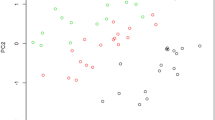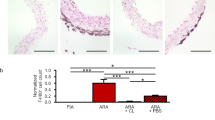Abstract
Permanent closure of the newborn ductus arteriosus requires the development of neointimal mounds to completely occlude its lumen. VEGF is required for neointimal mound formation. The size of the neointimal mounds (composed of proliferating endothelial and migrating smooth muscle cells) is directly related to the number of VLA4+ mononuclear cells that adhere to the ductus lumen after birth. We hypothesized that VEGF plays a crucial role in attracting CD14+/CD163+ mononuclear cells (expressing VLA4+) to the ductus lumen and that CD14+/CD163+ cell adhesion to the ductus lumen is important for neointimal growth. We used neutralizing antibodies against VEGF and VLA-4+ to determine their respective roles in remodeling the ductus of premature newborn baboons. Anti-VEGF treatment blocked CD14+/CD163+ cell adhesion to the ductus lumen and prevented neointimal growth. Anti-VLA-4 treatment blocked CD14+/CD163+ cell adhesion to the ductus lumen, decreased the expression of PDGF-B (which promotes smooth muscle migration), and blocked smooth muscle influx into the neointimal subendothelial space (despite the presence of increased VEGF in the ductus wall). We conclude that VEGF is necessary for CD14+/CD163+ cell adhesion to the ductus lumen and that CD14+/CD163+ cell adhesion is essential for VEGF-induced expansion of the neointimal subendothelial zone.
Similar content being viewed by others
Log in or create a free account to read this content
Gain free access to this article, as well as selected content from this journal and more on nature.com
or
Abbreviations
- COX:
-
cyclooxygenase
- ΔCT:
-
the difference in cycle threshold between the expression of the housekeeping gene MDH and the gene of interest
- eNOS:
-
endothelial NOS
- HP1/2:
-
monoclonal antibody against VLA-4
- MDH:
-
malate dehydrogenase
- MMP-9:
-
matrix metalloproteinase-9
- VCAM-1:
-
vascular cell adhesion molecule-1
- VE:
-
vascular endothelial cell
- VLA-4 or CD49d:
-
α4β1 integrin mononuclear cell adhesion receptor
References
Seidner SR, Chen Y-Q, Oprysko PR, Mauray F, Tse MM, Lin E, Koch C, Clyman RI 2001 Combined prostaglandin and nitric oxide inhibition produces anatomic remodeling and closure of the ductus arteriosus in the premature newborn baboon. Pediatr Res 50: 365–373
Clyman RI, Chan CY, Mauray F, Chen YQ, Cox W, Seidner SR, Lord EM, Weiss H, Wale N, Evan SM, Koch CJ 1999 Permanent anatomic closure of the ductus arteriosus in newborn baboons: the roles of postnatal constriction, hypoxia, and gestation. Pediatr Res 45: 19–29
Levin M, McCurnin D, Seidner SR, Yoder B, Waleh N, Goldbarg S, Roman C, Liu BM, Boren J, Clyman RI 2006 Postnatal constriction, ATP depletion, and cell death in the mature and immature ductus arteriosus. Am J Physiol Regul Integr Comp Physiol 290: R359–R364
Goldbarg S, Quinn T, Waleh N, Roman C, Liu BM, Mauray F, Clyman RI 2003 Effects of hypoxia, hypoglycemia, and muscle shortening on cell death in the sheep ductus arteriosus. Pediatr Res 54: 204–211
Clyman RI, Seidner SR, Kajino H, Roman C, Koch CJ, Ferrara N, Waleh N, Mauray F, Chen YQ, Perkett EA, Quinn T 2002 VEGF regulates remodeling during permanent anatomic closure of the ductus arteriosus. Am J Physiol Regul Integr Comp Physiol 282: R199–R206
Echtler K, Stark K, Lorenz M, Kerstan S, Walch A, Jennen L, Rudelius M, Seidl S, Kremmer E, Emambokus NR, von Bruehl ML, Frampton J, Isermann B, Genzel-Boroviczeny O, Schreiber C, Mehilli J, Kastrati A, Schwaiger M, Shivdasani RA, Massberg S 2010 Platelets contribute to postnatal occlusion of the ductus arteriosus. Nat Med 16: 75–82
Shah NA, Hills NK, Waleh N, McCurnin D, Seidner S, Chemtob S, Clyman R 2011 Relationship between circulating platelet counts and ductus arteriosus patency after indomethacin treatment. J Pediatr 158: 919.e2–923.e2
Kevil CG, Bullard DC 1999 Roles of leukocyte/endothelial cell adhesion molecules in the pathogenesis of vasculitis. Am J Med 106: 677–687
Libby P, Ridker PM, Maseri A 2002 Inflammation and atherosclerosis. Circulation 105: 1135–1143
Funayama H, Ikeda U, Takahashi M, Sakata Y, Kitagawa S, Takahashi Y, Masuyama J, Furukawa Y, Miura Y, Kano S, Matsuda M, Shimada K 1998 Human monocyte-endothelial cell interaction induces platelet-derived growth factor expression. Cardiovasc Res 37: 216–224
Abedi H, Zachary I 1995 Signalling mechanisms in the regulation of vascular cell migration. Cardiovasc Res 30: 544–556
Waleh N, Seidner S, McCurnin D, Yoder B, Liu BM, Roman C, Mauray F, Clyman RI 2005 The role of monocyte-derived cells and inflammation in baboon ductus arteriosus remodeling. Pediatr Res 57: 254–262
Springer TA 1990 Adhesion receptors of the immune system. Nature 346: 425–434
Keck PJ, Hauser SD, Krivi G, Sanzo K, Warren T, Feder J, Connolly DT 1989 Vascular permeability factor, an endothelial cell mitogen related to PDGF. Science 246: 1309–1312
Leung DW, Cachianes G, Kuang WJ, Goeddel DV, Ferrara N 1989 Vascular endothelial growth factor is a secreted angiogenic mitogen. Science 246: 1306–1309
Barleon B, Sozzani S, Zhou D, Weich HA, Mantovani A, Marme D 1996 Migration of human monocytes in response to vascular endothelial growth factor (VEGF) is mediated via the VEGF receptor flt-1. Blood 87: 3336–3343
Hiratsuka S, Minowa O, Kuno J, Noda T, Shibuya M 1998 Flt-1 lacking the tyrosine kinase domain is sufficient for normal development and angiogenesis in mice. Proc Natl Acad Sci USA 95: 9349–9354
Lumsden AB, Chen C, Hughes JD, Kelly AB, Hanson SR, Harker LA 1997 Anti-VLA-4 antibody reduces intimal hyperplasia in the endarterectomized carotid artery in nonhuman primates. J Vasc Surg 26: 87–93
Huo Y, Hafezi-Moghadam A, Ley K 2000 Role of vascular cell adhesion molecule-1 and fibronectin connecting segment-1 in monocyte rolling and adhesion on early atherosclerotic lesions. Circ Res 87: 153–159
Kling D, Fingerle J, Harlan JM, Lobb RR, Lang F 1995 Mononuclear leukocytes invade rabbit arterial intima during thickening formation via CD18-and VLA-4-dependent mechanisms and stimulate smooth muscle migration. Circ Res 77: 1121–1128
Labinaz M, Hoffert C, Pels K, Aggarwal S, Pepinsky RB, Leone D, Koteliansky V, Lobb RR, O'Brien ER 2000 Infusion of an antialpha4 integrin antibody is associated with less neoadventitial formation after balloon injury of porcine coronary arteries. Can J Cardiol 16: 187–196
Borgström P, Bourdon MA, Hillan KJ, Sriramarao P, Ferrara N 1998 Neutralizing anti-vascular endothelial growth factor antibody completely inhibits angiogenesis and growth of human prostate carcinoma micro tumors in vivo. Prostate 35: 1–10
Kim KJ, Li B, Winer J, Armanini M, Gillett N, Phillips HS, Ferrara N 1993 Inhibition of vascular endothelial growth factor-induced angiogenesis suppresses tumour growth in vivo. Nature 362: 841–844
Hodara VL, Velasquillo MC, Parodi LM, Giavedoni LD 2005 Expression of CD154 by a simian immunodeficiency virus vector induces only transitory changes in rhesus macaques. J Virol 79: 4679–4690
Giavedoni LD, Schlabritz-Loutsevitch N, Hodara VL, Parodi LM, Hubbard GB, Dudley DJ, McDonald TJ, Nathanielsz PW 2004 Phenotypic changes associated with advancing gestation in maternal and fetal baboon lymphocytes. J Reprod Immunol 64: 121–132
Bouayad A, Kajino H, Waleh N, Fouron JC, Andelfinger G, Varma DR, Skoll A, Vazquez A, Gobeil FJ, Clyman RI, Chemtob S 2001 Characterization of PGE2 receptors in fetal and newborn lamb ductus arteriosus. Am J Physiol Heart Circ Physiol 280: H2342–H2349
Waleh N, Kajino H, Marrache AM, Ginzinger D, Roman C, Seidner SR, Moss TJ, Fouron JC, Vazquez-Tello A, Chemtob S, Clyman RI 2004 Prostaglandin E2-mediated relaxation of the ductus arteriosus: effects of gestational age on g protein-coupled receptor expression, signaling, and vasomotor control. Circulation 110: 2326–2332
Clyman RI, Goetzman BW, Chen YQ, Mauray F, Kramer RH, Pytela R, Schnapp LM 1996 Changes in endothelial cell and smooth muscle cell integrin expression during closure of the ductus arteriosus: an immunohistochemical comparison of the fetal, preterm newborn, and full-term newborn rhesus monkey ductus. Pediatr Res 40: 198–208
Davies MJ, Gordon JL, Gearing AJ, Pigott R, Woolf N, Katz D, Kyriakopoulos A 1993 The expression of the adhesion molecules ICAM-1, VCAM-1, PECAM, and E-selectin in human atherosclerosis. J Pathol 171: 223–229
Dong ZM, Chapman SM, Brown AA, Frenette PS, Hynes RO, Wagner DD 1998 The combined role of P- and E-selectins in atherosclerosis. J Clin Invest 102: 145–152
Collins RG, Velji R, Guevara NV, Hicks MJ, Chan L, Beaudet AL 2000 P-Selectin or intercellular adhesion molecule (ICAM)-1 deficiency substantially protects against atherosclerosis in apolipoprotein E-deficient mice. J Exp Med 191: 189–194
Kunkel EJ, Ley K 1996 Distinct phenotype of E-selectin-deficient mice. E-selectin is required for slow leukocyte rolling in vivo. Circ Res 79: 1196–1204
Johnston B, Issekutz TB, Kubes P 1996 The alpha 4-integrin supports leukocyte rolling and adhesion in chronically inflamed postcapillary venules in vivo. J Exp Med 183: 1995–2006
Gaboury JP, Kubes P 1994 Reductions in physiologic shear rates lead to CD11/CD18-dependent, selectin-independent leukocyte rolling in vivo. Blood 83: 345–350
Alon R, Kassner PD, Carr MW, Finger EB, Hemler ME, Springer TA 1995 The integrin VLA-4 supports tethering and rolling in flow on VCAM-1. J Cell Biol 128: 1243–1253
Martinet Y, Bitterman PB, Mornex JF, Grotendorst GR, Martin GR, Crystal RG 1986 Activated human monocytes express the c-sis proto-oncogene and release a mediator showing PDGF-like activity. Nature 319: 158–160
Jackson CL, Raines EW, Ross R, Reidy MA 1993 Role of endogenous platelet-derived growth factor in arterial smooth muscle cell migration after balloon catheter injury. Arterioscler Thromb 13: 1218–1226
Walpola PL, Gotlieb AI, Cybulsky MI, Langille BL 1995 Expression of ICAM-1 and VCAM-1 and monocyte adherence in arteries exposed to altered shear stress. Arterioscler Thromb Vasc Biol 15: 2–10
Acknowledgements
We thank Dr. Napoleone Ferrara (Genentech) for providing us with MAb A.4.6.1. We also thank Ms. Vickie Winter, Dr. Jackie Coalson, and all the personnel at the BPD Resource Center and the University of Texas Health Science Center at San Antonio, Pathology Division.
Author information
Authors and Affiliations
Corresponding author
Additional information
Supported by grants from U.S. Public Health Service [NIH grants HL46691, HL56061, HL52636 BPD Resource Center, and P51RR13986 (NCRR)] and by a gift from the Jamie and Bobby Gates Foundation. This investigation was conducted in a facility constructed with support from Research Facilities Improvement Program Grant number C06 RR12087 (NCRR).
Rights and permissions
About this article
Cite this article
Waleh, N., Seidner, S., McCurnin, D. et al. Anatomic Closure of the Premature Patent Ductus Arteriosus: The Role of CD14+/CD163+ Mononuclear Cells and VEGF in Neointimal Mound Formation. Pediatr Res 70, 332–338 (2011). https://doi.org/10.1203/PDR.0b013e3182294471
Received:
Accepted:
Issue date:
DOI: https://doi.org/10.1203/PDR.0b013e3182294471
This article is cited by
-
Exploration of potential biochemical markers for persistence of patent ductus arteriosus in preterm infants at 22–27 weeks’ gestation
Pediatric Research (2019)
-
Genetic variants associated with patent ductus arteriosus in extremely preterm infants
Journal of Perinatology (2019)
-
Microarray gene expression analysis in ovine ductus arteriosus during fetal development and birth transition
Pediatric Research (2016)
-
Predictors of successful closure of patent ductus arteriosus with indomethacin
Journal of Perinatology (2015)
-
Isoprostanes as physiological mediators of transition to newborn life: novel mechanisms regulating patency of the term and preterm ductus arteriosus
Pediatric Research (2012)



